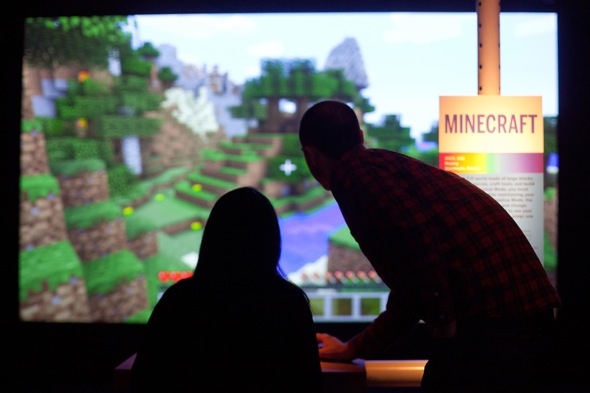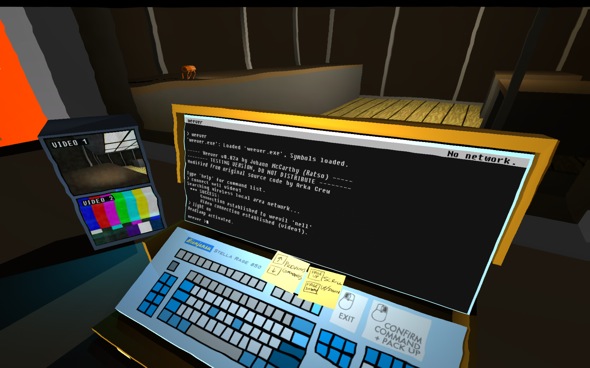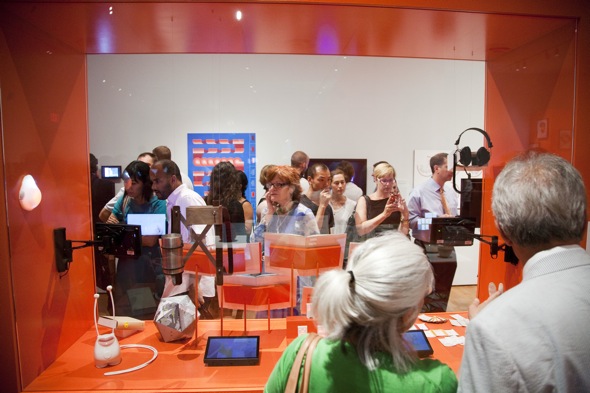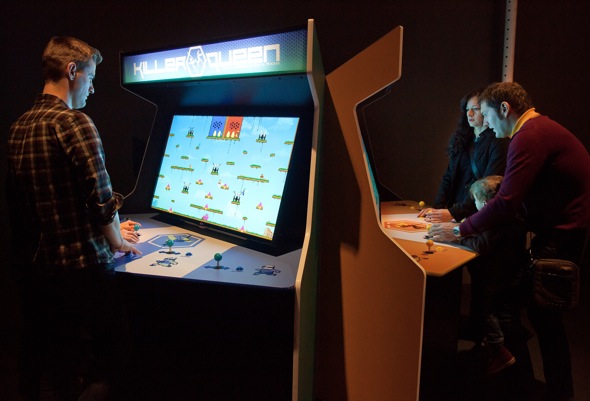
MINECRAFT (2011). Installation view, "Indie Essentials: 25 Must-Play Video Games" co-presented by Museum of the Moving Image and IndieCade. Photo: Ben Helmer.
I woke up early on an overcast and windy morning in January and caught the M train up to Astoria to spend the morning playing video games at the Museum of Moving Image. The current exhibition, co-organized by Jason Eppink and Indiecade—an international festival of indie games—is entitled "Indie Essentials," and is home to 25 ready-to-play titles on various platforms. The diverse selection of titles on view were installed with a keen attention to detail, and the exhibition was carefully structured. However, as I walked around the space and played nearly every title on display (or at least every single-player title), a question kept nagging at me: do video games belong in the museum?
This is not to say that I agree with the short-sighted, yet fascinatingly stringent, argument presented by Roger Ebert that video games cannot be art. Rather, "Indie Essentials" posed as an interesting example for the ways in which the museum as a site seems unfit to house this kind of media. This is not the fault of the Moving Image, or the organizers of the exhibition, by any means. The exhibition elegantly exhibited the works, providing ample space for players and viewers. But I'd argue that some of the experience of playing these games gets lost when presented in public space.
For instance, one of the first titles I chose to play was the Indiecade 2013 Grand Jury Award-winning game Quadrilateral Cowboy. Since this game is currently unreleased to the general public, I was eager to play as much of this as I could during my visit. After spending 30 minutes engrossed in a cyberpunk adventure, I had the sudden feeling that I was preventing other people from playing, and I became self-conscious of my own gameplay.

Still frame from Quadrilateral Cowboy (expected 2014). Courtesy of Blendo Games.
Museums have well-established conventions governing the hanging, mounting, and presentation of art objects, as well public/social interaction (although that's been changing as of late). The video game, however, presents a number of challenges to these conventions, which have become particularly pressing in light of the rate at which video games have quickly become a focus for a number of major institutions.
Pitfalls abound. For instance, the nationally traveling exhibition "The Art of Video Games" installed a variety of old and new video games into large projection booths, making gameplay an uncomfortably public performance, a gesture harkening back to the climatic sequences of Jimmy Woods' playing Super Mario Bros. 3 in The Wizard (1989). In this case, the museum imposed a stale and predigested mode of interaction onto a dynamic and engaging art form.
Another instance of problematic installation occurred in 2011 in the "Talk to Me" exhibition at MoMA with two pieces by Jason Rohrer (an artist also featured in "Indie Essentials"). Rohrer's work—well-known among indie gamers as deeply contemplative and existential—lost nearly all of its affect in the former exhibition as a result of being butted up against eye-catching infographics and pieces of interactive design. Passage (2008)—a tragic five-minute game that takes players through a low-bit sidescrolling meditation on aging and partnership—was installed with little attention paid to its soundtrack. The close proximity of this work to other media objects made it hard to digest, and my observations of players from afar revealed that they were unwilling (or unable) to take the comparatively concise amount of time to fully experience the work.

Installation view of Talk to Me: Design and the Communication between People and Objects at The Museum of Modern Art, 2011. Photo © Scott Rudd.
This is to say nothing about the stunted and unimaginative installation of Dwarf Fortress (2006) in "Talk to Me." This notoriously difficult and time-consuming work by Bay 12 Games was installed in such a way that concentration became impossible. Again, in bringing the game into a museum context, any potential dynamic interactivity of the title has been compacted into a familiar non-functional art object. By stripping the game of one of its fundamental qualities—play—the resulting exhibited work becomes little more than a snapshot artifact.
Titles like Passage and Dwarf Fortress, important works that require concentration and engagement, might benefit from a more considered installation treatment. In "Indie Essentials," works like The Fullbright Company's Gone Home—a rich, 3D interactive fiction requiring meticulous exploration of a suburban home—are given a setting that allows visitors to delve into more attentive gameplay, taking installation cues from video exhibitions.
There is still a problem, however: a good percentage of the games presented in this exhibition do not inherently entice players to dive right in. My initial experience of most games on display during the Moving Image exhibition was either a Main Menu or a stagnant pause screen. In either case, jumping into gameplay ranged from difficult to daunting.
Many of the games on view in "Indie Essentials" are most often experienced in the comfort of one's own home. By moving these titles unaltered into a public space such as the museum, the experience is drastically altered. Of course, museums are not the first place to present public gameplay: this tradition has been well-established by the arcade, and this important precedent should come back into the critical conversation of the ways in which video games can be incorporated into the gallery. Games developed for the arcade had demo screens, enticing prospective players to feed the machine their quarters. Similarly, contemporary art games and indie developers considering the gallery as a potential site for play must take into account the ways in which their titles could benefit from this installation method.
One such game within "Indie Essentials" took the conventions of the arcade game into account, and as a result, it was easily the most successfully installed game in the exhibition. Killer Queen Arcade, a 5v5 upright console featuring combative pollen collection, not only featured an enticing demo title-screen, it also offered a custom adaptation for an arcade-like setting. The title's suitability for public gameplay allowed the museum to host a series of tournament nights to be held over the course of the exhibition, offering a further avenue for public engagement.

Killer Queen Arcade (2012). Installation view, "Indie Essentials: 25 Must-Play Video Games." co-presented by Museum of the Moving Image and IndieCade. Credit: Photo: Ben Helmer.
The question becomes, how can a museum or gallery apply this strategy to games like The Chinese Room's Dear Esther (2007/2012) or Tale of Tales' The Path (2009)? It seems that developers themselves need to be convinced that the museum is an important site for the display of their work, worth the effort of creating a version suitable for public presentation. The idea that a work should be altered for display in the museum may rouse the ire of purists, and it raises unanswerable questions about archival titles. But until this begins to happens, museum exhibitions of video games can only ever be partially successful.
"Indie Essentials: 25 Must-Play Video Games," co-presented by Museum of the Moving Image and IndieCade, is on view at the Museum through March 2, 2014.